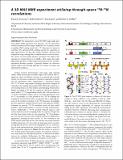| dc.contributor.author | Linse, Sara | |
| dc.contributor.author | Donovan, Kevin J | |
| dc.contributor.author | Silvers, Robert Paul Georg | |
| dc.contributor.author | Griffin, Robert Guy | |
| dc.date.accessioned | 2018-04-23T14:16:09Z | |
| dc.date.available | 2018-04-23T14:16:09Z | |
| dc.date.issued | 2017-05 | |
| dc.date.submitted | 2017-02 | |
| dc.identifier.issn | 0002-7863 | |
| dc.identifier.issn | 1520-5126 | |
| dc.identifier.uri | http://hdl.handle.net/1721.1/114858 | |
| dc.description.abstract | We demonstrate a novel 3D NNC magic angle spinning NMR experiment that generates ¹⁵N–¹⁵N internuclear contacts in protein systems using an optimized ¹⁵N–¹⁵N proton assisted recoupling (PAR) mixing period and a ¹³C dimension for improved resolution. The optimized PAR condition permits the acquisition of high signal-to-noise 3D data that enables backbone chemical shift assignments using a strategy that is complementary to current schemes. The spectra can also provide distance constraints. The utility of the experiment is demonstrated on an M₀Aβ₁₋₄₂ fibril sample that yields high-quality data that is readily assigned and interpreted. The 3D NNC experiment therefore provides a powerful platform for solid-state protein studies and is broadly applicable to a variety of systems and experimental conditions. | en_US |
| dc.description.sponsorship | National Institute of Biomedical Imaging and Bioengineering (U.S.) (Grant EB-001960) | en_US |
| dc.description.sponsorship | National Institute of Biomedical Imaging and Bioengineering (U.S.) (Grant EB-002026) | en_US |
| dc.language.iso | en_US | |
| dc.publisher | American Chemical Society (ACS) | en_US |
| dc.relation.isversionof | http://dx.doi.org/10.1021/jacs.7b01159 | en_US |
| dc.rights | Article is made available in accordance with the publisher's policy and may be subject to US copyright law. Please refer to the publisher's site for terms of use. | en_US |
| dc.source | Prof. Griffin via Erja Kajosalo | en_US |
| dc.title | 3D MAS NMR Experiment Utilizing Through-Space | en_US |
| dc.type | Article | en_US |
| dc.identifier.citation | Donovan, Kevin J. et al. “3D MAS NMR Experiment Utilizing Through-Space 15N–15N Correlations.” Journal of the American Chemical Society 139, 19 (May 2017): 6518–6521 © 2017 American Chemical Society | en_US |
| dc.contributor.department | Massachusetts Institute of Technology. Department of Chemistry | en_US |
| dc.contributor.department | Francis Bitter Magnet Laboratory (Massachusetts Institute of Technology) | en_US |
| dc.contributor.approver | Griffin, Robert Guy | en_US |
| dc.contributor.mitauthor | Donovan, Kevin J | |
| dc.contributor.mitauthor | Silvers, Robert Paul Georg | |
| dc.contributor.mitauthor | Griffin, Robert Guy | |
| dc.relation.journal | Journal of the American Chemical Society | en_US |
| dc.eprint.version | Author's final manuscript | en_US |
| dc.type.uri | http://purl.org/eprint/type/JournalArticle | en_US |
| eprint.status | http://purl.org/eprint/status/PeerReviewed | en_US |
| dspace.orderedauthors | Donovan, Kevin J.; Silvers, Robert; Linse, Sara; Griffin, Robert G. | en_US |
| dspace.embargo.terms | N | en_US |
| dc.identifier.orcid | https://orcid.org/0000-0001-5830-6748 | |
| dc.identifier.orcid | https://orcid.org/0000-0003-1589-832X | |
| mit.license | PUBLISHER_POLICY | en_US |
